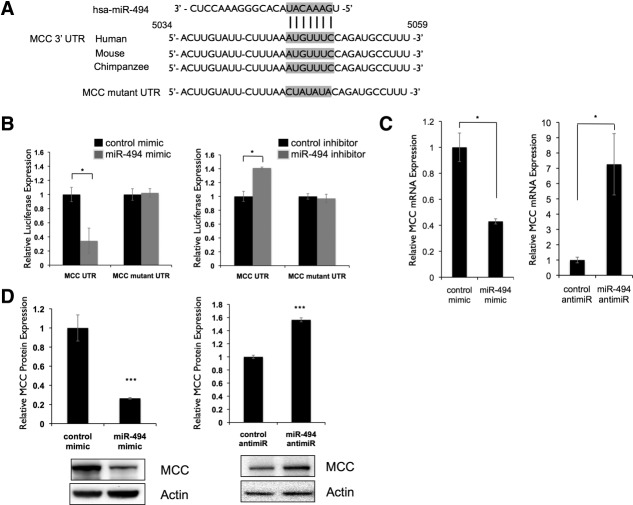Figure 4.
MCC is a direct target of miR-494. (A) Putative binding site of miR-494 in MCC 3′ UTR is conserved across multiple species. Alignment of human, mouse, and chimpanzee MCC 3′ UTRs shows a highly conserved region predicted to bind to miR-494. Predicted 7-mer binding seed of miR-494 to MCC 3′ UTR indicated with vertical lines. Putative binding site was mutated as indicated. (B) MCC 3′ UTR is a direct target of miR-494. A 300-bp region of the MCC 3′ UTR containing the predicted miR-494-binding site was cloned into a pMIR-REPORT luciferase vector. Activity of the reporter was decreased when cotransfected into LT2MR cells with miR-494 mimic and increased when cotransfected with miR-494 antimiR, compared to control cotransfections. *P < 0.05. In both cases, site-directed mutagenesis of the predicted miR-494-binding site resulted in loss of reporter response. (C) MCC mRNA expression is responsive to miR-494. LT2MR cells were transfected with miR-494 mimic or hairpin inhibitor and tested for MCC mRNA expression after 24 hours by qRT-PCR. Values normalized to sno202 and expressed relative to control transfected cells. *P < 0.05. (D) MCC protein expression is responsive to miR-494. LT2MR cells were transfected with miR-494 mimic or inhibitor and tested for MCC protein expression after 48 hours by western blotting. Graph is an average of three independent transfections, and values were quantified using a Bio-Rad ChemiDoc (Bio-Rad, Hercules, CA). ***P < 0.001.

